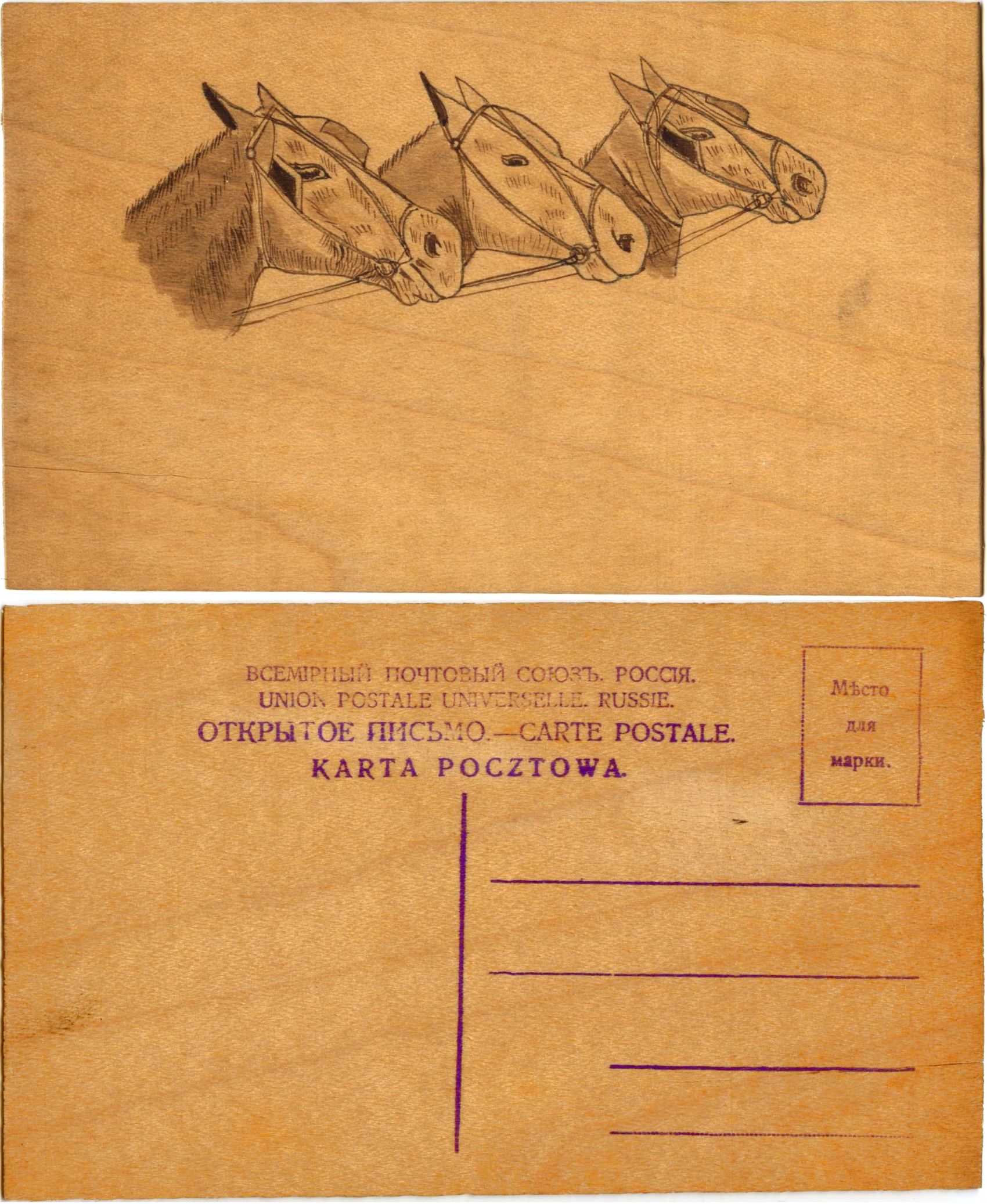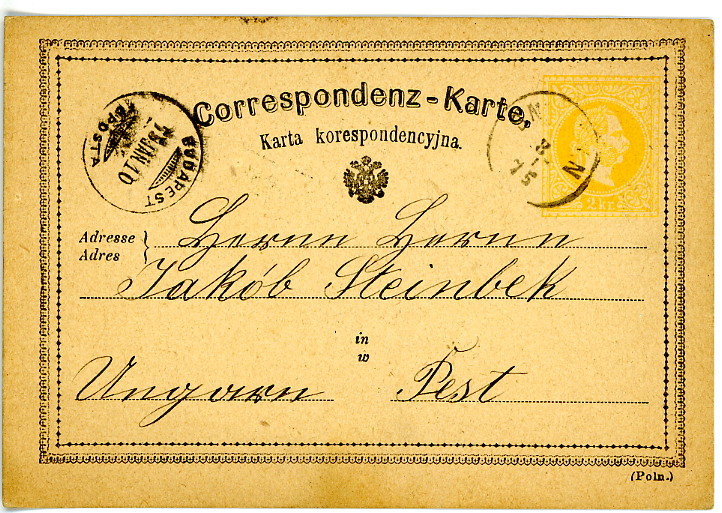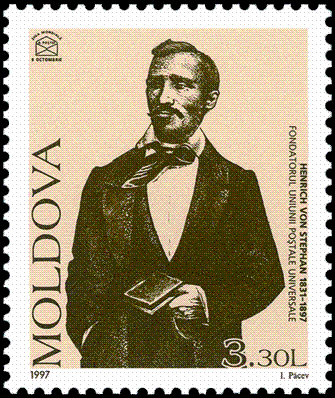|
Postcard
A postcard or post card is a piece of thick paper or thin cardboard, typically rectangular, intended for writing and mailing without an envelope. Non-rectangular shapes may also be used but are rare. There are novelty exceptions, such as wooden postcards, copper postcards sold in the Copper Country of the U.S. state of Michigan, and coconut "postcards" from tropical islands. In some places, one can send a postcard for a lower fee than a letter. Stamp collectors distinguish between postcards (which require a postage stamp) and postal cards (which have the postage pre-printed on them). While a postcard is usually printed and sold by a private company, individual or organization, a postal card is issued by the relevant postal authority (often with pre-printed postage). Production of postcards blossomed in the late 19th and early 20th centuries. As an easy and quick way for individuals to communicate, they became extremely popular. The study and collecting of postcards is terme ... [...More Info...] [...Related Items...] OR: [Wikipedia] [Google] [Baidu] |
Deltiology
Deltiology (from Ancient Greek, Greek , , diminutive of , , "writing tablet, letter"; and , ) is the study and collecting, collection of postcards. The word was first coined by Professor Randall Rhoades of Ashland, Ohio, in 1945. However, it took about twenty years for it to first appear in a dictionary.Postcard Collector's Magazine: Postcard Enterprises Inc., Palm Bay, Florida, First Issue January 1976, page 15 Compared to philately, the identification of a postcard's place and time of production can often be an impossible task because postcards, unlike stamps, are produced in a decentralised, unregulated manner. For this reason, some collectors choose to limit their acquisitions to cards by specific artists and publishers, or by time and location. History Deltiology appeared at the end of the 19th century, when the mass production of postcards began and received international distribution as the cheapest type of postal items. The first postcard was published in 1869, and by 187 ... [...More Info...] [...Related Items...] OR: [Wikipedia] [Google] [Baidu] |
World's Oldest Postcard
The Penny Penates is a postcard that was posted on 14 July 1840 to Fulham in London. It was addressed to the writer and practical joker Theodore Hook, who was probably also its sender and artist. The hand-painted design on the postcard shows an image of post office clerks sitting around a giant ink well. The postcard was discovered in 2001 by a stamp dealer while he was examining a stamp collection, and verified by the British Philatelic Association's expert committee as genuine and the world's oldest known postcard. It is also the only known surviving example of a Penny Black stamp, the world's first adhesive postage stamp, used on a postcard. It was sold at auction in 2002 for £31,750 (US$44,300), the most ever paid for a postcard. Design The Penny Penates is a postcard made of paper. The front features a hand-drawn colour illustration showing a gathering of caricatured postal clerks with huge pens seated around an enlarged inkwell marked "Official." To the left and rig ... [...More Info...] [...Related Items...] OR: [Wikipedia] [Google] [Baidu] |
Wood Postcard
Wood postcards have been produced and sold in the U.S. as keepsakes. Postcardy.com Wooden postcards were sold for the 1904 St. Louis World's Fair held in . Many included puns associated with wood: "Exposition is more than oak-a", "it is ash-tonishing", I wood spruce up and come", "You walnut regret it." and "Butternut delay". The of 1905 and the |
Emanuel Herrmann
Emanuel Alexander Herrmann (24 June 1839 in Klagenfurt, Austria13 July 1902 in Vienna) was an Austrian national economist. He is considered the decisive last in an international line of inventors of the postal card. Life and work After graduating with a law doctorate from the University of Vienna, Emanuel Herrmann, the son of the Bezirkshauptmann (district administrator) of Klagenfurt,R. Zimmerl: ''126 Jahre Postkarte''. In: Die Briefmarke Nr. 10/1994; ebenfalls erschienen in: Manfred Stippich (Redaktion): ''Die Postkarte. Dr. Emanuel Herrmann – eine österreichische Erfindung erobert die Welt'', Ausstellungskatalog, Klagenfurt 1995, S. 10–15. entered the civil service in the Austrian ministry of commerce and qualified for a university career as a "Privatdozent" in the field of national economics. He was also a professor at the renowned Theresian Military Academy in Wiener Neustadt and from 1882 for twenty years professor of national economics at Vienna's Institute of Tec ... [...More Info...] [...Related Items...] OR: [Wikipedia] [Google] [Baidu] |
Postal Card
Postal cards are postal stationery with an imprinted stamp or indicium signifying the prepayment of postage. They are sold by postal authorities. On January 26, 1869, Dr. Emanuel Herrmann of Austria described the advantages of a ''Correspondenz Karte''. By October 1, 1869 the world's first postal card was produced by Austria-Hungary.Van Gelder, Peter J.; ''The Collectors' Guide to Postal Stationery'', A Squirrel Publication (1997) They caught on quickly. By the end of 1870, Great Britain, Finland, Switzerland and Württemberg joined the countries issuing postal cards. In the United States, they were first produced in 1873.Bussey, Lewis E., Ed.; ''United States Postal Card Catalog'', United Postal Stationery Society, 2010, 248 pages. A complete and authoritative look at U.S. postal cards. Some of the forms taken by postal cards include the regular single card which may be commemorative or definitive, attached message-reply cards, airmail postal cards, and official postal c ... [...More Info...] [...Related Items...] OR: [Wikipedia] [Google] [Baidu] |
Theodore Hook
Theodore Edward Hook (22 September 1788 – 24 August 1841) was an English man of letters and composer and briefly a civil servant in Mauritius. He is best known for his practical jokes, particularly the Berners Street hoax in 1809. The world's first postcard was received by Hook in 1840; he likely posted it to himself. Biography Early life Hook was born in Charlotte Street, Bedford Square, London. His father, James Hook (1746–1827), was a composer; his elder brother, also called James Hook, became Dean of Worcester. He spent a year at Harrow School and subsequently matriculated at the University of Oxford. His father took delight in exhibiting the boy's musical and metrical gifts, and the precocious Theodore became a pet of the green room. At the age of 16, in conjunction with his father, he scored a dramatic success with ''The Soldier's Return'', a comic opera, and it followed up with a series of popular ventures with John Liston and Charles Mathews, including ''T ... [...More Info...] [...Related Items...] OR: [Wikipedia] [Google] [Baidu] |
Camp Conlie
Camp Conlie was one of eleven military camps established by the Republican Government of National Defense under Léon Gambetta during the Franco-Prussian war. It became notable because of events which have led to its being described as a "concentration camp", in which troops from Brittany were supposedly incarcerated and persecuted. This became a significant atrocity story within Breton nationalism. Background After the defeat of French forces at the Battle of Sedan, and the fall of the monarchy of Napoleon III, a new republic was proclaimed. The new government decided to form a new army and continue the war. Major General Émile de Kératry was made responsible for establishing a camp at Conlie in the region of Le Mans and mobilized volunteers from the west of France to form an "army of Brittany". The mobilized quota from the five departments of Brittany was 80,000 men. It was intended that these troops would be equipped with the weapons left over from the American Civil War, b ... [...More Info...] [...Related Items...] OR: [Wikipedia] [Google] [Baidu] |
Heinrich Von Stephan
Ernst Heinrich Wilhelm von Stephan (born Heinrich Stephan, January 7, 1831 – April 8, 1897) was a general post director for the German Empire who reorganized the German postal service. He was integral in the founding of the Universal Postal Union in 1874, and in 1877 introduced the telephone to Germany. Biography Stephan was born in Stolp (Słupsk), Pomerania, in the Kingdom of Prussia. He began his career as a local postal clerk in the service of the Prussian post in 1849. In 1866 he was put in charge by the Prussian government of federalizing the postal service that had long been privately run by the noble Thurn und Taxis family. In 1870 he was named director of postal services for the North German Confederation. Stephan's career then moved quickly up the ranks, as he was named Postmaster General of the German Empire in 1876, the Undersecretary of State in charge of the post office in 1880, and the Minister of Postal Services for Germany in 1895. When Stephan began his wor ... [...More Info...] [...Related Items...] OR: [Wikipedia] [Google] [Baidu] |
Fulham
Fulham () is an area of the London Borough of Hammersmith & Fulham in West London, England, southwest of Charing Cross. It lies on the north bank of the River Thames, bordering Hammersmith, Kensington and Chelsea. The area faces Wandsworth, Putney, Barn Elms and the London Wetland Centre in Barnes. on the far side of the river. First recorded by name in 691, Fulham was a manor and ancient parish which originally included Hammersmith. Between 1900 and 1965, it was the Metropolitan Borough of Fulham, before its merger with the Metropolitan Borough of Hammersmith created the London Borough of Hammersmith and Fulham (known as the London Borough of Hammersmith from 1965 to 1979). The district is split between the western and south-western postal areas. Fulham has a history of industry and enterprise dating back to the 15th century, with pottery, tapestry-weaving, paper-making and brewing in the 17th and 18th centuries in present-day Fulham High Street, and later involvement in ... [...More Info...] [...Related Items...] OR: [Wikipedia] [Google] [Baidu] |
Stamp Collecting
Stamp collecting is the collecting of postage stamps and related objects. It is an area of philately, which is the study (or combined study and collection) of stamps. It has been one of the world's most popular hobbies since the late nineteenth century with the rapid growth of the postal service, as a never-ending stream of new stamps was produced by countries that sought to advertise their distinctiveness through their stamps. Collecting Stamp collecting is generally accepted as one of the areas that make up the wider subject of philately, which is the study of stamps. A philatelist may, but does not have to, collect stamps. It is not uncommon for the term ''philatelist'' to be used to mean a stamp collector. Many casual stamp collectors accumulate stamps for sheer enjoyment and relaxation without worrying about the tiny details. The creation of a large or comprehensive collection, however, generally requires some philatelic knowledge and will usually contain areas of philate ... [...More Info...] [...Related Items...] OR: [Wikipedia] [Google] [Baidu] |
Card Stock
Card stock, also called cover stock and pasteboard, is paper that is thicker and more durable than normal writing and printing paper, but thinner and more flexible than other forms of paperboard. Card stock is often used for business cards, postcards, playing cards, catalogue covers, scrapbooking, and other applications requiring more durability than regular paper gives. The surface usually is smooth; it may be textured, metallic, or glossy. When card stock is labeled cover stock, it often has a glossy coating on one or both sides (''C1S'' or ''C2S'', for "coated: one side" or "coated: two sides"); this is used especially in business cards and book covers. Measurements Most nations describe paper in terms of grammage—the weight in grams of one sheet of the paper measuring one square meter. Other people, especially in the United States, describe paper in terms of pound weight—the weight in pounds per ream (500 sheets) of the paper with a given area (based on historica ... [...More Info...] [...Related Items...] OR: [Wikipedia] [Google] [Baidu] |
Philadelphia
Philadelphia, often called Philly, is the largest city in the Commonwealth of Pennsylvania, the sixth-largest city in the U.S., the second-largest city in both the Northeast megalopolis and Mid-Atlantic regions after New York City. Since 1854, the city has been coextensive with Philadelphia County, the most populous county in Pennsylvania and the urban core of the Delaware Valley, the nation's seventh-largest and one of world's largest metropolitan regions, with 6.245 million residents . The city's population at the 2020 census was 1,603,797, and over 56 million people live within of Philadelphia. Philadelphia was founded in 1682 by William Penn, an English Quaker. The city served as capital of the Pennsylvania Colony during the British colonial era and went on to play a historic and vital role as the central meeting place for the nation's founding fathers whose plans and actions in Philadelphia ultimately inspired the American Revolution and the nation's inde ... [...More Info...] [...Related Items...] OR: [Wikipedia] [Google] [Baidu] |








